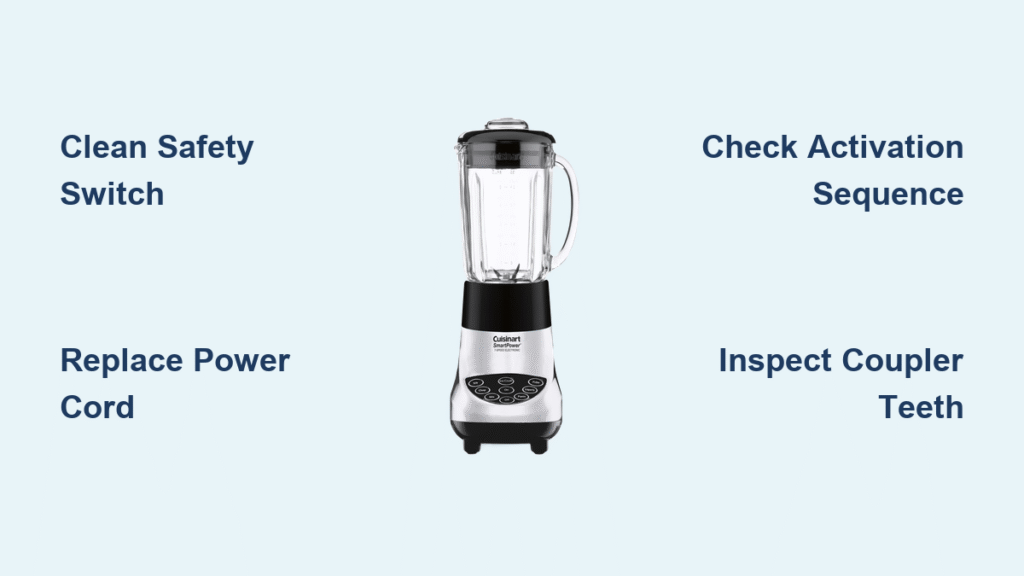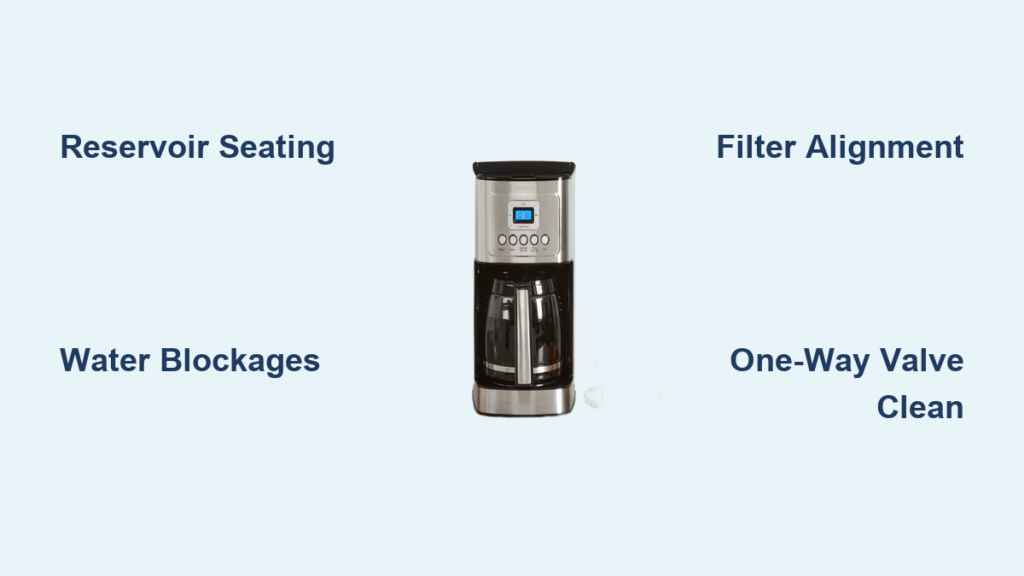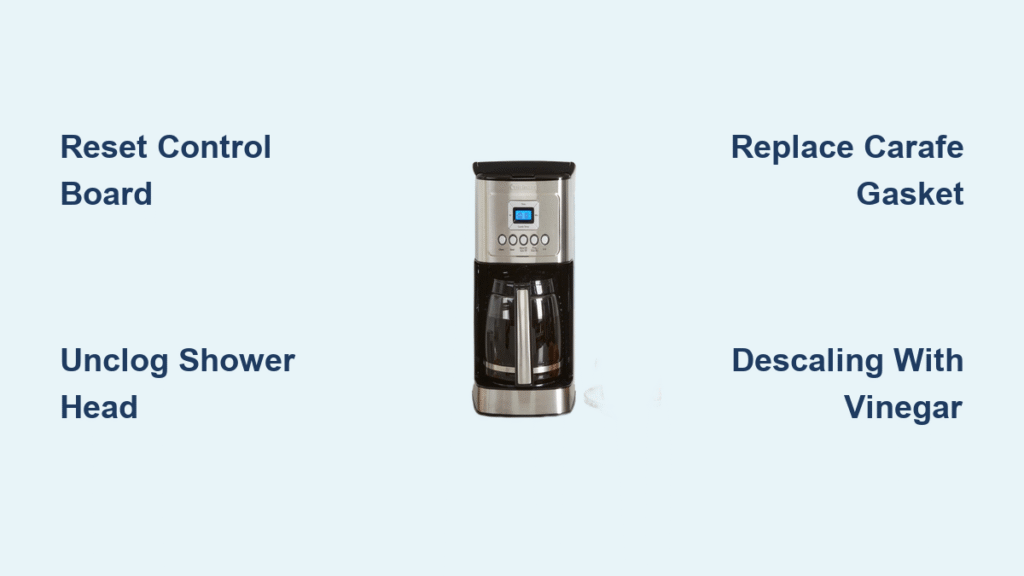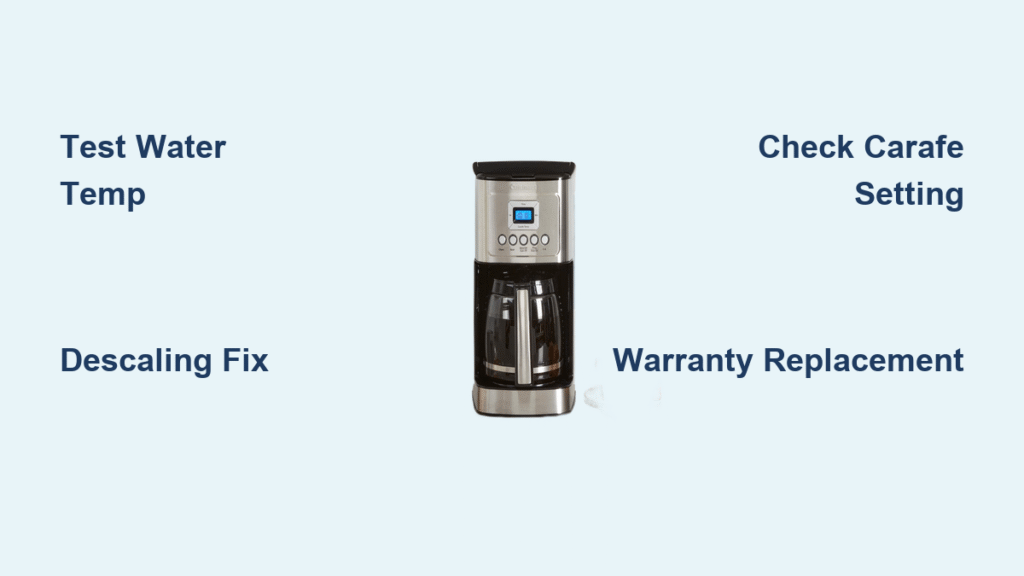Your morning routine crashes to a halt when your Cuisinart blender refuses to spin. That familiar hum is missing, the blades stay frozen, and your smoothie ingredients sit motionless. Whether you own the compact CPB-380 portable model or the versatile SBC-1000 cooking blender, this guide delivers immediate fixes for your Cuisinart blender not spinning crisis. Most issues resolve in under 20 minutes with basic tools—no technician required. Stop staring at that lifeless pitcher; you’ll diagnose the exact problem and restore blending power before your next meal.
Identify Your Cuisinart Blender Failure Type in 30 Seconds
Don’t waste time on irrelevant fixes—pinpoint your exact issue first. These visual and audio clues eliminate guesswork:
Zero Response? (No lights, no sound) → Focus on power delivery issues
Red Light Only? (Solid or flashing indicator) → Check model-specific activation sequences
Motor Humming? (Electrical buzz with motionless blades) → Target mechanical blockages
Smoke or Burning Smell? → Stop immediately; indicates serious motor damage
Weak Spin? (Blades rotate slowly or stall) → Inspect for debris or worn components
Critical first step: Unplug the unit and manually rotate the blade assembly with your fingers (power OFF). If it spins freely, your problem likely involves electrical components. If stuck solid, debris or corrosion is jamming the mechanism.
CPB-380 Safety Switch Repair That Works in 60 Seconds

The CPB-380 portable blender’s #1 failure—Cuisinart blender not spinning with zero response—traces to a clogged safety switch. Located inside the cup connection port, this tiny black button prevents operation when debris blocks full cup seating.
Fix it now:
1. Remove the blending cup and inspect the rear of the connection port
2. Press the black button gently with a toothpick—it must move smoothly
3. If stuck, clean around it with a damp cotton swab (dry thoroughly after)
4. Reattach the cup firmly until you hear a distinct click
Pro Tip: Coffee grounds and dried smoothie residue are frequent culprits. Clean this switch weekly by running the cup under warm water after each use. This 60-second maintenance prevents 90% of CPB-380 failures.
Replace Damaged Power Cords Before They Cause Fire Hazards
When your Cuisinart blender shows zero response despite being plugged in, test the power cord immediately. Damaged cords cause 35% of “dead” blender incidents and pose fire risks.
Warning signs requiring replacement:
– Visible fraying or cuts near the plug
– Cord feels unusually hot during use
– Blender works only at specific cord angles
Safe replacement steps:
1. Unplug and flip the base upside down
2. Remove the 4-6 bottom plate screws
3. Photograph wire connections before disconnecting
4. Install an OEM cord assembly ($18-$25 from Cuisinart Parts)
Never attempt cord repairs with electrical tape. This temporary fix risks short circuits. Complete replacement takes 15 minutes with a Phillips screwdriver and prevents dangerous electrical faults.
Crack the SBC-1000 Flashing Light Code in 4 Steps

SBC-1000 owners often mistake normal operation for failure when their Cuisinart blender not spinning shows flashing red lights. This indicates standby mode—not a malfunction—requiring a specific activation sequence even for cold blending.
Correct activation sequence:
1. Press the Power ON/OFF button (light turns solid red)
2. Set cooking timer using +/- buttons (1-30 minutes)
3. Select temperature (High/Medium/Low)
4. Turn function dial to Pulse, Stir, or Blend
Cold blending shortcut: For smoothies or dips, set timer to 1 minute on Low temperature. Skipping any step prevents blade rotation—this is the #1 user error for SBC-1000 models.
Free Seized Blades With These Two Techniques
Manual Rotation Rescue for Minor Debris
When blades won’t turn manually (power OFF), debris is jamming the mechanism. Do not force rotation—this damages the coupler.
Gentle release method:
– Fill pitcher halfway with warm water and dish soap
– Run blender for 30 seconds on low
– Rinse thoroughly while rotating blades by hand
– Repeat if residue persists
Critical warning: Never soak Duo Blender series overnight—water penetrates seals and causes corrosion lock.
Corrosion Lock Fix for Duo Blenders
If blades remain frozen after cleaning, corrosion has welded components. This requires careful disassembly:
- Hold blades firmly with one rag
- Turn the rubber coupler counter-clockwise with a second rag
- Apply WD-40 to stuck threads and wait 5 minutes
- Reassemble with food-grade grease ($4 at appliance stores)
Never use pliers—they crack plastic housings. If threads are stripped, order a replacement blade assembly ($12 from Cuisinart).
Stop Coupler Stripping Before It Kills Your Motor

Stripped couplers cause 60% of “motor humming, blades motionless” failures. These plastic connectors between motor and blades wear down from heavy loads.
Spot failure instantly:
– Remove pitcher and inspect both coupler halves
– Look for rounded, flattened teeth (not sharp edges)
– Check base for plastic shavings—confirming gear damage
Replacement protocol:
1. Order model-specific coupler set ($10)
2. Remove pitcher and unscrew blade assembly
3. Pull off worn coupler from drive shaft
4. Press new coupler firmly onto shaft until seated
Pro Tip: Apply silicone-based grease annually to coupler teeth. This doubles their lifespan and prevents the grinding noise that precedes failure.
Diagnose Motor Humming With This 3-Step Test
When your Cuisinart blender not spinning emits a loud hum, perform this critical diagnostic:
Step 1: Manually rotate blades (power OFF). If stiff, clean blade assembly per Section 5.
Step 2: Check base for plastic shavings—indicating stripped gears requiring motor replacement.
Step 3: If blades spin freely with no debris, suspect capacitor failure (common in older models).
Critical safety note: Capacitor replacement involves opening the motor housing—do not attempt without electrical training. This $8 part requires soldering skills; seek professional help if uncomfortable.
Drive Shaft Inspection That Predicts Motor Death
Your drive shaft reveals motor health in 10 seconds. After unplugging and removing the pitcher:
Test procedure:
1. Attempt to rotate the metal drive shaft by hand
2. Spins freely? → Capacitor likely failed (fixable)
3. Stiff or immovable? → Motor bearings seized (requires replacement)
Warning sign: If shaft rotates with grinding noises, metal fragments are inside—stop using immediately. Continuing operation destroys the entire motor assembly.
Prevent Future Failures With This 4-Point Maintenance Plan
Avoid recurring Cuisinart blender not spinning issues with these proven habits:
After every use:
– Rinse blade assembly under warm water immediately
– Dry completely before reassembly (moisture causes corrosion)
Monthly:
– Inspect coupler teeth for wear
– Tighten blade assembly if loose (snug but not forced)
Annually:
– Apply food-grade grease to drive shaft and coupler
– Check power cord for damage
Never exceed: 60 seconds of continuous blending without a 2-minute cool-down break. Overheating destroys motors faster than any other factor.
When to DIY vs. Call a Professional
Safely DIY these fixes:
– Cleaning safety switches (CPB-380)
– Replacing blades or couplers
– Power cord replacement
– Basic debris removal
Require professional help:
– Motor replacement ($45-80 part cost)
– Capacitor or wiring repairs
– Any work under warranty (3-year coverage)
Warranty pro tip: Cuisinart honors claims even after DIY attempts if you document repairs. Photograph each step before disassembly—this preserves coverage for electrical components.
Emergency Fixes When You Need Blending Power Now
Cooking oil breakthrough: Add 2 tbsp vegetable oil to pitcher and run 2 minutes. Lubricates seized mechanisms instantly.
Grape seed oil soak: Submerge blade assembly overnight, then work back-and-forth by hand. Dissolves stubborn residue.
Electric tape shim (temporary): Wrap drive shaft with 2 layers of tape to improve coupler grip—lasts 3-5 uses while ordering parts.
Use these only as stopgaps—permanent repairs prevent further damage.
Final Troubleshooting Checklist Before Replacement
Before declaring your Cuisinart blender dead, verify these 6 critical points:
– [ ] Safety switch cleaned (CPB-380 models)
– [ ] SBC-1000 activation sequence completed
– [ ] Blades rotate freely when power OFF
– [ ] Coupler teeth show no wear or rounding
– [ ] Power cord tested with continuity meter
– [ ] Zero plastic shavings in motor base
Most “dead” Cuisinart blenders revive with these steps. If problems persist after this checklist, contact Cuisinart Support with your model number—they often ship free parts for common failures even outside warranty. Remember: Your 3-year warranty covers electrical and motor defects, so never pay for covered repairs. With these proven fixes, your Cuisinart blender not spinning becomes a solved problem before lunchtime.





